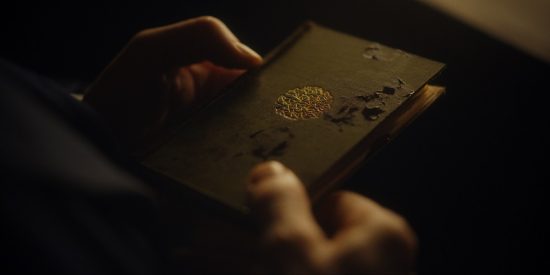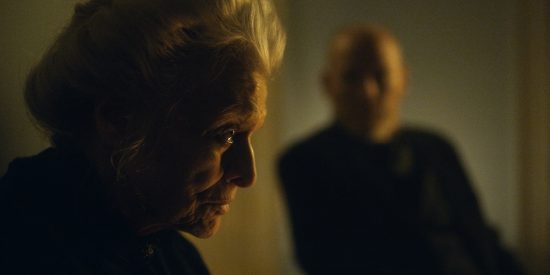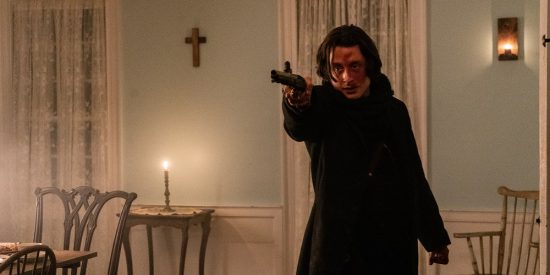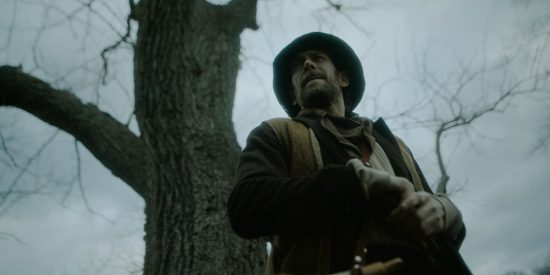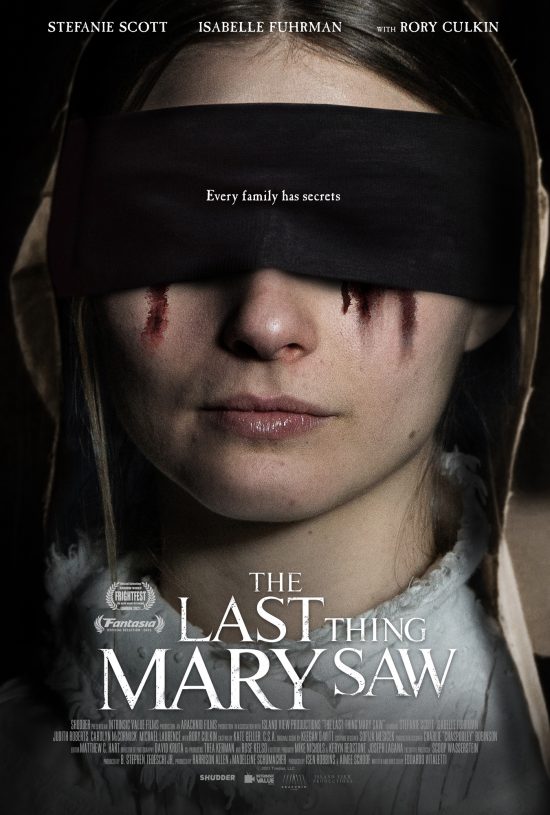Screenwriting, religious repression and why you should watch The Last Thing Mary Saw: In conversation with filmmaker Edoardo Vitaletti
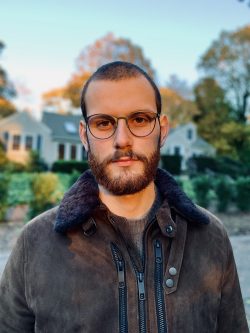 One of the most exciting aspects of covering film releases is the opportunity to discover new talent with the potential to breathe new life into an industry prone to creative regurgitation. The horror genre offers a wide spectrum of possibilities but it’s often easy to play safe by following the typical jump-scary slasher path. Luckily that’s not the case with New York-based Italian filmmaker Edoardo Vitaletti, whose feature debut The Last Thing Mary Saw makes bold narrative choices, defying most expectations, as I illustrated in my review.
One of the most exciting aspects of covering film releases is the opportunity to discover new talent with the potential to breathe new life into an industry prone to creative regurgitation. The horror genre offers a wide spectrum of possibilities but it’s often easy to play safe by following the typical jump-scary slasher path. Luckily that’s not the case with New York-based Italian filmmaker Edoardo Vitaletti, whose feature debut The Last Thing Mary Saw makes bold narrative choices, defying most expectations, as I illustrated in my review.
This week I had the pleasure of chatting with the writer/director and fellow Italian abroad on Zoom as his stylish and gorgeously shot first feature has just launched exclusively on Shudder, after having its world premiere at the Fantasia Film Festival overseas and its UK one at FrightFest back in the summer. It’s a well-deserved accomplishment for the young filmmaker who’s originally from Monza (near Milan) and is a film graduate of the prestigious Tisch School of the Arts, Film and Television at New York University.
Given my background and focus on screenwriting we dive into our conversation touching upon the compelling themes at the heart of this peculiar horror. Despite entailing a supernatural central mystery and providing its fair share of disturbing moments that get under your skin, this is a gothic period piece set in Puritan America in the 1800s, slow burning its way through the psychodrama of a forbidden queer love story. At the beginning of the film, young Mary’s bleeding eyes are covered with a blindfold as she is being questioned by a constable about the mysterious circumstances surrounding her grandmother’s sudden passing and other tragic events that followed. She immediately reveals that her troubles began when her overly zealous Calvinist family found out about her secret love for the young maid Eleanor.
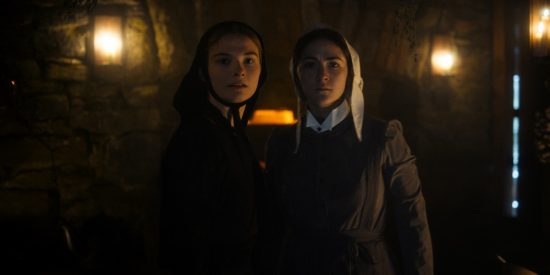
Stefanie Scott as Mary, Isabelle Fuhrman as Eleanor – The Last Thing Mary Saw – Photo Credit: Shudder
As the interrogation delves deeper into the sinful cause that led up to this moment, Mary challenges the constable’s religious point of view by noting that Lucifer was an angel before we cast the name of the devil upon him, hence God creates enemies in order to perform his good. It’s the old conundrum of good vs evil diluted in that simplistic religious black and white. I tell Edoardo how this line struck me as what the whole film is about and he agrees:
“With the making of this film my goal was to expose the frustrating fragility of hyper religious Christian communities that I’ve seen in my life a lot, having grown up in Italy in a Catholic setting as far as school and social circles. It’s the fragility of people who seem to be almost creating an enemy out of something that deserves to be experienced freely, just so that they can correct it. The term correction in the movie means something very specific but in general sometimes when I think of Christianity and the preaching aspect of it, there is an obsession for creating reasons to correct people’s behaviour. This family and the way they approach the daughter’s relationship with the maid is them really kind of exposing this fragility. So yes, I think that line was emblematic to state the theme of the movie.”
When it comes to portraying this forbidden love in the oppressive and claustrophobic Puritan household where all the action takes place, Stefanie Scott (Insidious: Chapter 3) and Isabelle Fuhrman (Orphan) do a wonderful job at subverting any cliché of the case. Whilst Mary (Scott) is keen to run away, Eleanor (Fuhrman) is not afraid to stand by their truth and face their opponents, even if it means being forced into the tortures of “correction”. Given recent examples of “scandalous” lesbian affairs in period settings such as Ammonite and Portrait of a lady on fire I wonder if the filmmaker at any moment had thought about having two males for the love story. He answers that it would’ve been just as interesting but explains why he wrote the script for two women:
“The concept that I wanted to explore was that of identity which you can relate to, having also grown up in Italy. We’re not even taught about what identity means – what your sexual identity or gender identity really mean – and so I think in that respect the story would’ve worked in different ways just as well with two males. However, one of the aspects I really enjoyed exploring was the role of women in that type of society because when it comes to having the character of the maid in a household of that type in 1840, it would’ve always been a woman. Had this relationship been between two men it would’ve been a little harder to contextualise who the male protagonist would’ve had a relationship with, because there wouldn’t have been a male servant. My two lead actresses were very curious about learning the body language, the formality that was imposed upon women at that time in history, like how they literally had to keep their shoulders and their hands a certain way. By contrast, the figure of the intruder that’s played by Rory Culkin is this male, patriarchal obstacle that enters the story and puts the wrench in the works for them. So, I think having two female protagonists just gave me a chance to tackle more things that I wanted to explore.”
One of the most interesting elements of the film is its circular structure revolving around a sinful book that’s introduced in the Puritan household, which ties in with the mysterious occurrences wreaking havoc in the quiet farm. Mary finding the book is the film’s opening image and the way the story is told around it prompted a question about Edoardo’s process in crafting such an intriguing narrative puzzle:
“I always knew how I wanted to end the movie and how I wanted to tell the story. I always envisioned it as a tragedy, maybe like in a Shakespearian sense I did imagine the lead character partially succeeding in her endeavour but ultimately finding her downfall and so for me the device of the book was very useful because it just created this sense of doom, of inescapability that I always knew would serve as the ending to my story. To be honest it took my editor and I a while to find the right beginning of the movie and I don’t quite remember entirely how it was in the script now, but I don’t think the script started exactly with the book opening. I wrote this movie four or five years ago and it changed a lot and I think I’ve grown a lot, and the one thing I truly learned is that when you edit a movie, that’s another stage of screenwriting. When we opened the edit and we started to put the main storyline together we realised that starting with the book that almost presents itself like a friendly presence and ultimately speaks to their doom felt right but it’s something that we solidified in the editing part of the writing process, which is really where the writing ends ultimately.”
It may have been cliché to ask a first-time director what was the biggest lesson he learned on set but Edoardo is such an interesting and eloquent interviewee so I couldn’t help my curiosity and his point of view on the topic is indeed refreshing:
“There are certainly aspects of the story and the movie that didn’t come together as you envisioned when you’re dealing with limited resources, that’s always going to happen. I think the one thing I learned is more on the spiritual level. I had crafted a story that doesn’t necessarily offer a cathartic or uplifting ending and I think my attitude on set while making it was also to remain very self-serious about it and kind of embrace the darkness of it. I think working with my actors who have a lot of experience in the genre and with some crew members who have more experience than me on a set reminded me that no matter what story you’re telling, you still have to approach the process with some levity, being able to crack a laugh in between takes, find your own personal catharsis. If something doesn’t go the way you planned, that’s ok, it’s going to go a different way. I think finding that freedom inside your process is very important.”
To wrap up our chat I challenge the filmmaker to try and convince our readers to check out his movie over any of the myriad other choices at their fingertips in this golden age of streaming platforms and infinite content. His pitch is rather on point:
“What I love about movies and the movies that I choose to watch recently more and more is that – because there is so much choice out there – they must have an experiential weight to them, and it has to feel like you’re not just following a story or taking a character’s journey but you’re experiencing something that’s reaching a little bit deeper. I think what I was trying to do with my film is to create that kind of visceral, experiential, atmospheric journey for the audience so I hope that when you pick my movie you’re forgetting about anything else for an hour and a half which is something I like to do when I watch movies, however flawed, and my movie has flaws but I think the experiential value of it is something that I would advise people to check out.”
The Last Thing Mary Saw is streaming exclusively on Shudder now.

